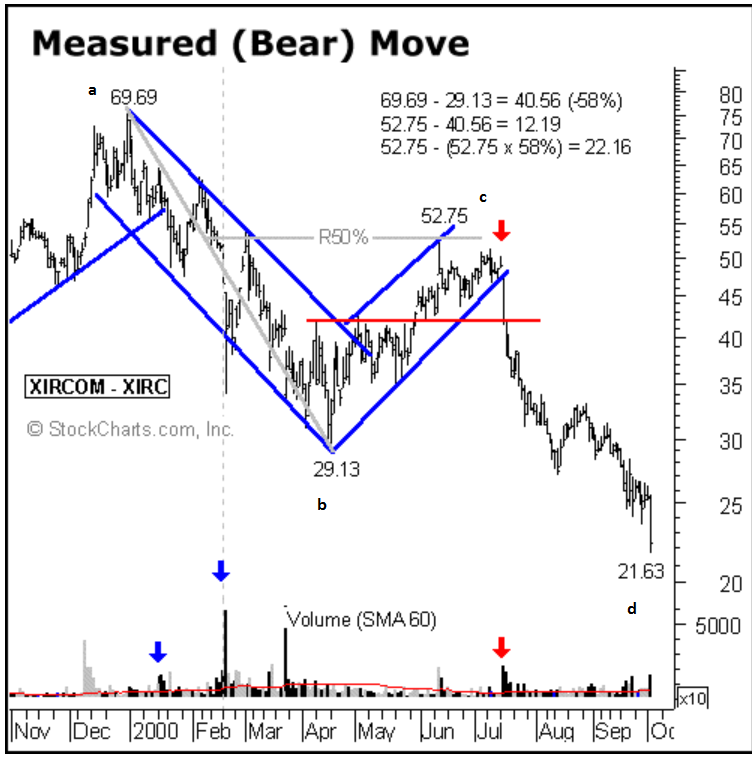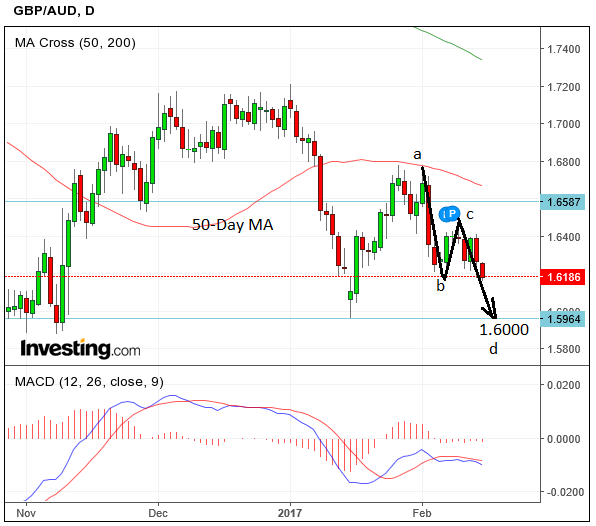Australian Dollar About to Push Pound Back to 2016 Lows

The Australian Dollar continues to dominate its British cousin - this year the Pound to Australian Dollar exchange rate has declined some 5.46% taking us down to ~1.6163 in mid-February.
The Aussie Dollar appears to be benefiting as investors borrow funds in Pounds and invest in Australian Dollar based assets.
This makes sense - the cost of borrowing in the UK remains at record lows while Australian sovereign debt offers superior yield.
This phenomenon - called the carry trade - is not unique to just AUD, we are also seeing it in other crosses such as GBP/ZAR.
It should therefore come as little surprise then when we report our latest near-term forecasts for GBP/AUD suggest the declines are likely to extend.
GBP/AUD is probably forming a three-wave pattern called a measured move, otherwise known as an a-b-c-d pattern – of the bearish variety.
The final c-d leg is unfolding lower and it has broken below the ‘b’ wave lows increasing the probability that it will continue down to a target at 1.6000.
The target is calculated from the length of the original a-b leg extrapolated down since the two waves are expected to be of similar length.
As can be seen in the above the decline is likely to take us down to the lows registered earlier in 2017 and in late 2016.
The 1.60 point has been tested on occassion but Sterling bears have been unsuccessful in prompting a noted break.
We would be confident that the selling pressure would run out at this point.
Until then though, we have full confidence in the Australian Dollar's ability to strengthen against its British counterpart.
Australian News and Data in the Second Half of the Week
The next major release for the Aussie is on Thursday, February 16 at 00.30 GMT when January Employment Data will be released.
The data is expected to show the Unemployment Rate remaining at 5.8% and the number of newly employed rising by 10k.
Given the upbeat statement from the Reserve Bank of Australia (RBA) at their February meeting, an unexpectedly good employment report could see Aussie gains as the possibility of the RBA raising rates may come back on the table.
News and Data for Sterling
The Pound weakened on Wednesday following worse than expected average earnings data which came out at 2.6% instead of the 2.8% expected (and 2.8% previously), in January.
Earnings are indicative of inflation and therefore future monetary policy from the Bank of England (BOE).
A rise in earnings leads to higher inflation, leads to the BOE raising interest rates and this pushes up the Pound because more foreign investors are likely to transfer their capital to the UK to receive the higher interest return being offered there.
Currently the usual relationship between inflation and earnings, however, appears to have broken down, because inflation is being pushed higher, not by more spending, but by the weak Pound, which has pushed up the cost of imports.
The slowing wage recovery is weakening the Pound because it could slow economic growth down as people will have less spare cash to spend due to wages not rising as fast as inflation.
“The trouble is inflation is rising at an anti-Goldilocks rate - neither bad enough nor mild enough. It's not fast enough for the Bank of England to hike interest rates, nor slow enough to stop economists fretting about its growth-sapping erosion of consumers’ buying power.
“With average wages now rising only a shade faster than prices, the wheels could fall off the consumer boom that has so far powered the UK economy through much of the post-referendum turbulence,” said David Lamb, commenting on the data, who is head of Dealing at FEXCO.
This feeds into the next major release for the Pound, on Friday, February 17, when Retail Sales for January is published at 09.30 GMT.
Analysts are expecting a slowdown due to wages not rising as quickly as previously and therefore people consuming less.
Of course, the rising cost of imports may also be putting shoppers off due to rising price-tags.
Nevertheless, consensus estimates are for Retail Sales year-on-year (yoy) to show a rise of 3.5%, and 1.0% month-on-month (mom).
Core Retail Sales are forecast to rise by 3.8% yoy and 0.7% mom.







